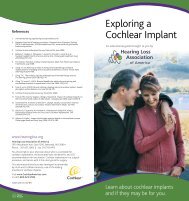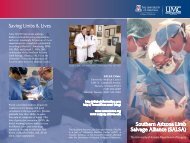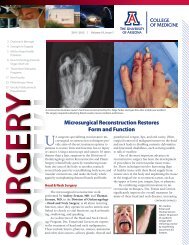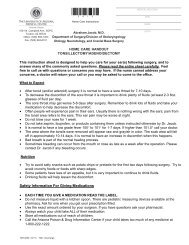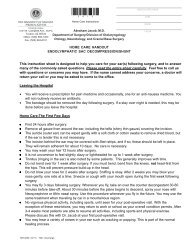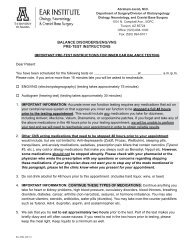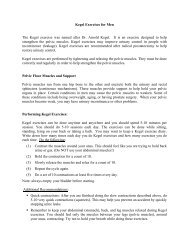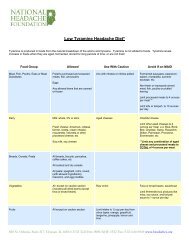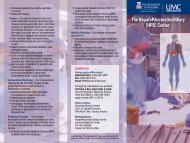Open Prostatectomy Preparation - University of Arizona
Open Prostatectomy Preparation - University of Arizona
Open Prostatectomy Preparation - University of Arizona
You also want an ePaper? Increase the reach of your titles
YUMPU automatically turns print PDFs into web optimized ePapers that Google loves.
Radical <strong>Prostatectomy</strong>Peri-operative Information<strong>University</strong> <strong>of</strong> <strong>Arizona</strong> Section <strong>of</strong> UrologyMitchell H. Sokol<strong>of</strong>f, M.D., F.A.C.S••Please review this document immediately afterscheduling your surgery and make sure to bring it withyou when you are admitted to the hospital••
Sokol<strong>of</strong>f; RRPPreparing for SurgeryConfirming Your Surgery Date and Time?Dr. Sokol<strong>of</strong>f will assign you a surgery date. On the afternoon <strong>of</strong> the day prior to yoursurgery (between 2 and 4pm), call 694-6359 to confirm the check-in time and location.In addition, Dr. Sokol<strong>of</strong>f has staff members that coordinate surgery scheduling. They can bereached at (520) 694-6502. Follow-up appointments will be arranged at the time <strong>of</strong>discharge from the hospital.Pre-Operative <strong>Preparation</strong>: The day before surgeryDiet: Begin a clear liquid diet one full day prior to your surgery. Clear liquids diet consists<strong>of</strong> any liquid that you can pour in a clear glass hold up to the light and see through withoutanything floating in it. [Some examples are: apple juice, clear soups and broths, c<strong>of</strong>fee andtea without cream, clear gelatin, grape juice, cranberry juice, sodas, and popsicles c<strong>of</strong>fee andtea (without creamer).] You may have all the clear liquids you wish until midnight, thennothing after midnight until after your surgery.Laxative: In the morning the day before surgery, drink one bottle (10 ounces) <strong>of</strong> magnesiumcitrate in addition to the clear liquids. [Magnesium citrate can be purchased at a pharmacywithout a prescription.] Stay close to a bathroom, as magnesium citrate is a powerfullaxative.The purpose <strong>of</strong> the clear liquid diet and laxative is to decompress the intestinesand to clean the rectum should there be the need to remove a small amount <strong>of</strong> therectal wall next to the prostate.You should take no food or fluid (nothing by mouth) after midnight. The anesthesiologyteam will provide you with instructions regarding what medications to take the morning <strong>of</strong>surgery. Other than the sip <strong>of</strong> water needed to help swallow the medications, any additionalintake <strong>of</strong> fluids or food may result in your surgery being cancelled.Stop blood thinners (such as aspirin, Coumadin, and Plavix) one week prior tosurgery. If you are taking blood thinners, please check with your primary doctor and/orcardiologist to make sure it is safe to stop prior to surgery.Suggestions for the Hospital Stay: Bring loose-fitting clothes with you to the hospital. Do not bring valuables with you.3
Sokol<strong>of</strong>f; RRPThe Hospital StayThe Hospital Stay: What to ExpectThe usual stay in the hospital is 2 days. Dr. Sokol<strong>of</strong>f’s patients are typically assigned toward 3N, located on the 3 rd floor <strong>of</strong> <strong>University</strong> Medical Center. Only half the rooms areprivate, so there is a chance that you will share the room with one other patient.When you arrive at the hospital the morning <strong>of</strong> surgery, you will go to the Pre-op Unit(located on the first floor <strong>of</strong> <strong>University</strong> Medical Center). You will be interviewed by severaldifferent members <strong>of</strong> the surgery team to insure that we properly identify each patient andtheir scheduled operation (as per national guidelines).When you come out <strong>of</strong> surgery you will be taken to the PACU (Post-Anesthesia Care Unit,or recovery room) for an approximate 2-hour stay. No visitors are allowed in the PACU.After your 2-hour stay in the PACU, you will be taken to your room on the third floor.You will have an IV in your arm and a urinary catheter coming out <strong>of</strong> your penis. You maynotice that your urine is pink or red and have blood clots (and it might last for a week or so).There will be a special wound dressing over the incision. There will also be a drain, called aJP bulb suction drain, which is used to monitor for bleeding and leakage <strong>of</strong> urine. At severaltimes during your hospital stay, blood will be taken to assess blood counts and kidneyfunction.Medications: During your hospital stay, you will be given a stool s<strong>of</strong>tener (to help preventconstipation), pain medication, antibiotics, anti-nausea drugs, and anti-inflammatorymedications. You will resume most <strong>of</strong> your regular medicines.Diet: You can drink fluids after surgery. You will probably not receive solid food until thesecond day after surgery. It is very important to eat slowly and cautiously during the hospitalrecovery as the effects <strong>of</strong> anesthesia and surgery can induce nausea and over-eating can causevomiting and potential disruptions <strong>of</strong> suture lines.Walking: You will be expected to get out <strong>of</strong> bed the night after surgery and walk 3-4 times aday. This will help with bowel function and to prevent blood clots. When in bed, make sureyou wear pulsatile stockings (placed during surgery) on your legs, as they also help preventblood clots. You will also be given an incentive spirometer, a breathing device that helpsprevent pneumonia.Dr. Sokol<strong>of</strong>f and the resident physicians will visit you everyday while you are in the hospital.Discharge Instructions: Prior to discharge, you will receive instructions on how to use andchange the catheter bags (the catheter needs to remain for 12-14 days) and the drains (if youare being sent home with it). Instructions will also be provided regarding diet, showering,and activity restrictions.4
Sokol<strong>of</strong>f; RRPPain Assessment:If you are having pain, let your nurse or doctor know so they can treat the pain. Be sure to letyour nurse know how your pain medicine is working. Rate your pain on a scale <strong>of</strong> “0” to“10” with “0” meaning no pain and “10” the worst pain you could imagine.Types <strong>of</strong> Pain You Might Experience after Prostate Surgery: Incisional pain. Bladder spasms: this can occur at any time while you have a catheter. This is <strong>of</strong>tendescribed as cramping in the low abdomen or the sensation or having to urinate eventhough the catheter is draining urine. The intensity <strong>of</strong> discomfort with spasms canrange from nonspecific to very severe. There might be some leakage <strong>of</strong> urine aroundthe catheter. This is normal. Non-narcotic medications will be available to help controlthis type <strong>of</strong> discomfort. Gas pain: this usually appears during the first day or two after surgery and is due to theslow movement <strong>of</strong> the bowel after surgery. This is <strong>of</strong>ten described as crampingpressure that may move across the abdomen. Walking is recommended for this type <strong>of</strong>discomfort because it helps restore normal bowel activity which increases the ability topass gas. Pain medications are generally not effective for this type <strong>of</strong> discomfort. Scrotal/ penis swelling and bruising: this usually appears during the first 2 days aftersurgery and is due to fluid shifts in the body after surgery. Walking and keeping thescrotum and penis elevated on a rolled towel while lying or sitting in bed or in the chairwill help your body reabsorb these fluids faster. An ice pack used occasionally mayalso be helpful and will be provided if recommended by your doctor. This swellingand/or bruising will gradually disappear, but it may take a week or two to completelyresolve. Urethral pain: usually appears in the first few days after surgery and is caused byirritation from the catheter going through your urethra and into your bladder. Thisdiscomfort is most <strong>of</strong>ten described as burning at the tip <strong>of</strong> the penis. You may also seebloody mucus drainage from around your catheter. The nursing staff will provide youwith a device to keep your catheter secured to your leg. This will prevent the catheterfrom moving around too much or from being tugged. It is important to keep the tip <strong>of</strong>your penis and the catheter itself clean and free <strong>of</strong> any dried drainage. Do not usealcohol or hydrogen peroxide to clean these areas. They are too drying and irritating.Use a warm, wet washcloth in the shower daily. Do not manipulate your catheter or tryto remove it: this can cause damage to the bladder-urethral reconnection. It may be difficult for you to tell the difference between some <strong>of</strong> these types <strong>of</strong> pain ordiscomfort. It is important for you to talk to your nurse about how you feel so they cantreat your pain appropriately.5
Sokol<strong>of</strong>f; RRPThe Foley Catheter:This is the catheter which helps the bladderurethralreconnection heal. Premature removalcan cause scar tissue and structures so it isusually left in place for 12-14 days. The Foleycatheter is held in place by a balloon inside thebladder. Removal is nasally painless, but needsto be done by Dr. Sokol<strong>of</strong>f or one <strong>of</strong> his staff.The catheter allows continuous urine drainageinto a collection bag. During the day, use the smaller leg bag that is strapped to youthigh. It must be emptied at least every two hours, and more frequently if you are makinga lot <strong>of</strong> urine. During the night, use the larger hospital-type bag. It does not need to beemptied as <strong>of</strong>ten as the leg bag.When you get into bed, make sure that the drainage tube is not kinked or looped, andthat the bag is hanging <strong>of</strong>f the side <strong>of</strong> the bed. Also make sure that it is draining urineas an obstruction to the catheter or tube can cause your bladder to fill and cause thebladder to rupture. Do not use scissors or a knife near your catheter.The catheter will extend out <strong>of</strong> your urethra. The urethra is the tube inside you that drainsurine from your bladder to the outside <strong>of</strong> your body. Your urine may be pink becausethere may be some blood in it. If this happens, try to decrease your activity level andincrease your intake <strong>of</strong> fluids.A small amount <strong>of</strong> leakage or drainage <strong>of</strong> urine or the discharge <strong>of</strong> sticky fluid fromaround the catheter is normal. It is important to keep the area around the catheter clean tohelp prevent an infection. Your in-hospital nurse will tell you how to clean it and how<strong>of</strong>ten you should do this. You may shower daily with the catheter in place.Do not pull on the catheter because this will make you hurt or bleed.Do not kink or lay on the catheter because the urine will not be able to drain.Do not lift the bag <strong>of</strong> urine above your waist. If you do this, the urine will flowback into your bladder. This can cause an infection.After the catheter is removed, it is important that you do not wait when you need tourinate. Find a restroom as soon as you can. Most individuals do not have good urinarycontrol when the catheter is first removed. Urinary control will gradually improve as yourecover.Discharge PlanningThis will begin after surgery the day <strong>of</strong> surgery. If you have home care needs, the CaseManagement and UMC nursing staff will help you in meeting these needs.6
Sokol<strong>of</strong>f; RRPGoing HomeAfter You Leave the Hospital:Medications: Keep a written list <strong>of</strong> the medicines you take, the amounts, and when andwhy you take them. Bring the list <strong>of</strong> your medicines or the pill bottles when you see yourprimary care provider. Do not take any medicines, over-the-counter drugs, vitamins,herbs, or food supplements without first talking to primary care provider. Always takeyour medicine as directed. Call your primary care provider if you think your medicinesare not helping or if you feel you are having side effects. Do not quit taking yourmedicines until you discuss it with your primary care provider. If you are takingantibiotics, take them until they are all gone even if you feel better.If you are taking painmedications or medicine that makes you drowsy, do not drive, operate machinery ormake important decisions.Showering: You can shower when you get home. Carefully remove any bandages and letthe warm water flow over the small surgical incision areas. Blot them dry and put onclean, new bandages. Change your bandages any time they get wet or dirty. You mayhave steri-strips (thin strips <strong>of</strong> tape) or staples on your incision. It is okay to shower withstaples, steri-strips and/or stitches. The steri-strips start to peel <strong>of</strong>f in 3 to 6 weeks, letthem fall <strong>of</strong>f by themselves. Keep them clean and dry.Bowel Movements (BMs): It may be hard for you to have a BM after surgery. You willbe given stool s<strong>of</strong>teners to keep you from getting constipated. Constipation means thatyou are unable to have a BM for more than 3 days. If this happens, call Dr. Sokol<strong>of</strong>f’s<strong>of</strong>fice and a management plan can be developed. Do not try to push the BM out if it istoo hard for at least 6 weeks. Pushing too hard can make you bleed. Walking is the bestway for you to get your bowels moving. Also, eat foods high in fiber to make it easier tohave a BM. Good examples are high fiber cereals, beans, vegetables, and whole grainbreads. Metamucil can be bought at drug and grocery stores and might be helpful. Prunejuice may help make the BM s<strong>of</strong>ter. Milk <strong>of</strong> Magnesia can also be taken. Do not useenemas or suppositories for 6 weeks after surgery.Other things to expect after surgery: You may feel like you have to urinate more <strong>of</strong>tenthan you used to for 6 to 8 weeks after surgery. You may also feel that you have tourinate immediately. You may leak urine, have trouble starting the flow <strong>of</strong> urine, or havea weak urine stream. This is normal and should go away with time. You may pass a darkbrown or tan colored clump <strong>of</strong> tissue in your urine after about 6 to 8 weeks. Your urinemay then be pink or blood-tinged the next few times you urinate. This is a normal part <strong>of</strong>healing and should also go away with in hours to a couple <strong>of</strong> days.Perineal Discomfort: The perineum is between the scrotum and the rectum. It iscommon to feel pressure and discomfort in this region, especially when sitting. Useibupr<strong>of</strong>en (Advil and Motrin are examples), usually 600 mg every 8 hours, until thisresolves. Acetaminophen (Tylenol) 1 gram every 6 hours is also effective. Sitting on adonut cushion is helpful.Numbness: It is normal for the area around your incision to be numb after surgery. Thisshould go away in less than a year.7
Sokol<strong>of</strong>f; RRPBlood in Urine. It is common to have blood in your urine, especially at the end <strong>of</strong>urination, for up to 8 weeks. This is sometimes associated with a twinge <strong>of</strong> pain. If thishappens, rest, drink lots <strong>of</strong> water, and avoid lifting and straining.Rest and Activity: You may feel like resting more than usual after surgery.Make sure you walk 4-6 times a day.Slowly start to do more each day. Rest when you feel it is needed. Do not lift anythingheavier than 15 pounds for 6 weeks after surgery.Do not sit in one place for hours at a time (like in a car). This can cause blood clots t<strong>of</strong>orm in your legs.Do not drive a car for 2 weeks after surgery (as long as the catheter is in place).You may return to work in 4 to 6 weeks (whenever you feel comfortable doing so).You may have sexual intercourse 6 weeks from surgery, if you feel ready. Dr. Sokol<strong>of</strong>fwill discuss this topic with you at your 6-week follow-up appointment and providemanagement strategies. Stop sexual activity if it causes pain. You may be able to have anorgasm but you will not have semen (sperm) come out. Because the prostate and seminalvesicles were removed, you will no longer ejaculate when you have an orgasm. You mayleak urine during orgasm. This is normal and there are methods to deal with it. It maytake a year for erections to occur. During the rehabilitation process, you will be <strong>of</strong>feredpills and/or penis injections and/or urethral suppositories and/or vacuum erection devicesto assist in the recovery <strong>of</strong> sexual function.Drink at least 6 to 8 (soda pop can size) glasses <strong>of</strong> liquid each day. Good liquids to drinkare water, juices, and milk. Limit the amount <strong>of</strong> caffeine you drink. Drinking fluids mayhelp prevent infection and urinary problems. It will also help your stools stay s<strong>of</strong>t.Exercising after surgery:Talk to your doctor before you start exercising. Together you can plan the best exerciseprogram for you. It is best to start slowly and do more as you get stronger. Do not exercisevigorously for at least 6 weeks after surgery.Keep all appointments: Call the urology clinic at (520) 694-4032 for a follow-up visit 10 to 14days after surgery. Typically, the incision site will be examined and the urinary catheter will beremoved as well. Bring a small supply <strong>of</strong> “Guards for Men” to this follow-up appointment. Youcan find these at any drug store.Kegel Exercises: Kegel Exercises are used to strengthen the pelvic floor muscles and tohelp with the return <strong>of</strong> urinary control. You may start them 2 to 3 days after surgery.Breathe normally while doing these exercises. Squeeze your pelvic muscles: the muscles<strong>of</strong> your anus and your penis. Squeeze, hold for a few seconds and relax these muscles. Do10 repetitions 3 to 4 times a day or as <strong>of</strong>ten as you can.8
Sokol<strong>of</strong>f; RRPEMERGENCIESBelow is a list <strong>of</strong> conditions that warrant a call to Dr. Sokol<strong>of</strong>f’s <strong>of</strong>fice. There are several waysto reach Dr. Sokol<strong>of</strong>f. The following phone numbers may be used. We suggest starting with thepage operator, as it is the method that will get the most prompt response. Page Operator (ask to speak with the Urology Resident On-call): (520) 694-6000 Urology Clinic: (520) 694-4032 Urology Office: (520) 696-6236 If you feel that you have a life-threatening condition, call 911.The following conditions warrant an immediate call. Shaking chills. Chest pain or shortness <strong>of</strong> breath. Calf pain or pain in lower legs; unusual warmth <strong>of</strong> the lower legs. Leg pain with walking. Vomiting or abdominal cramps; abdominal swelling. Your bandage becomes soaked with blood; prolonged bleeding at an incision site orthrough the catheter. Fluid draining through the incision. Any drainage that is green or brown and smells foul. You get a temperature over 101.5 degrees. Your stitches or staples are swollen, red, or have pus coming from them. No urine draining from the catheter. A feeling <strong>of</strong> pressure in your bladder with decreased amounts <strong>of</strong> urine draining into thecatheter bag. Large amounts <strong>of</strong> blood in the urine or a lot <strong>of</strong> large blood clots in the urine. A lot <strong>of</strong> leaking around the catheter tip (a small amount is normal).Questions or Concerns?520-694-6000(ask for the UrologistOn-call)9




